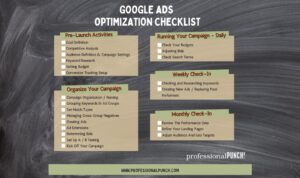Follow these suggestions to prepare your content for a voice search to help make Siri and Alexa find you first—and be rewarded with 30% more business!
“Hey Siri, where can I find a pizza shop near me?”
“Alexa, call Domino’s, please.”
“OK Google, where can I get a pizza with anchovies?”
We are people on the move. More and more, we are finding ways to use artificial intelligence to assist in keeping our hands free and saving us time. A voice search allows us to have search results read aloud by a voice assistant like Siri or Google. Voice search results are prompt and to the point. Whether you’re a GenZ person who has no problem asking questions into your phone, or if you’re a boomer trying not to get annoyed while speaking to Alexa—one thing is certain: voice search is on the rise (50% of all searches) and will continue to grow.
- An estimated voice search optimization
- Voice shopping is now a $40 billion market, and set to grow to $56.7 billion by 2026
- 58% of U.S. consumers use voice search for a local business on a smartphon
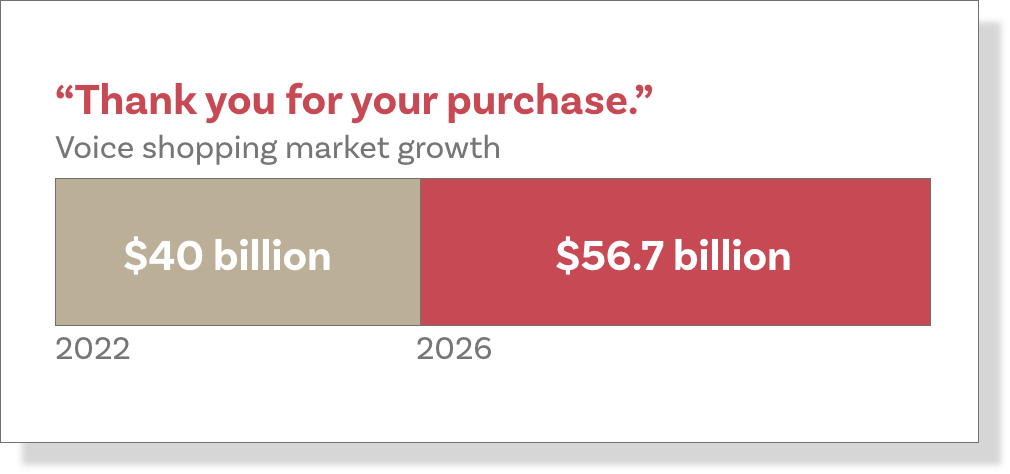
Voice search is faster, easier, more convenient, and most of the time more appropriate. In a recent poll, the main reasons people prefer to use the voice search are:
43%
It’s quicker than going to a website or using an app
42%
I can use it when I’m driving or when I’m using my hands
38%
It’s more fun
38%
It’s faster than going to a website or using an app
28%
It’s more accurate
28%
I hate typing on my phone
Make your SEO rank, and make bank:
Why optimizing for the voice search will boost sales
Your marketing effort needs to include optimizing for voice search as part of your overall SEO strategy. Local businesses and location-specific businesses can benefit most from the voice search. Think about it: more than one billion searches are made each month, and over 55% of people use voice search to find nearby businesses.
More importantly, optimizing your website for voice search can increase your sales by 30%.
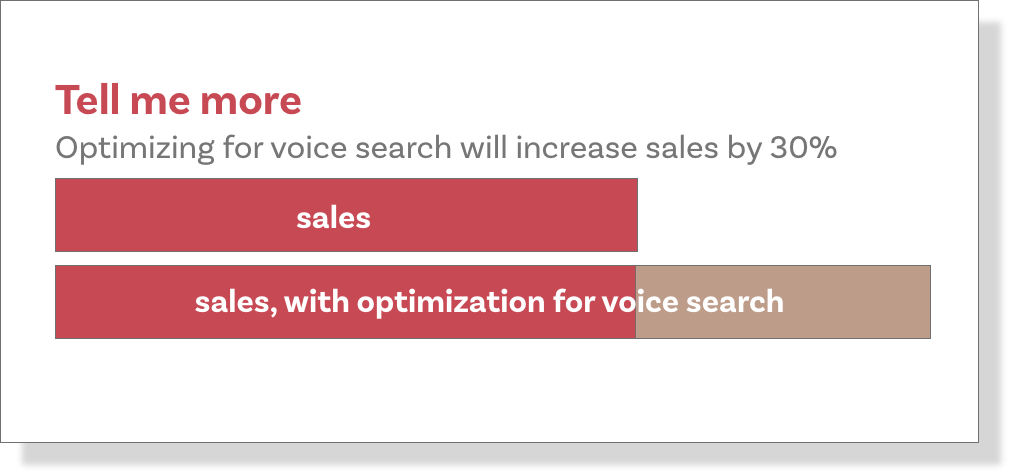
Not all content is appropriate for the voice search. Our digital assistants can deliver information back that is a direct answer to the question, but they cannot display a page of results because they have no screen. This differs from a text search in which we are looking for an array of answers, such as on search engine results pages (SERPs). For example, we can ask by voice for directions to the pizza shop and get the quick, short answer we need. Alternatively, we will want to use text search when we need to shop for shoes, or real estate, so that we receive many answers.
“Use your words”
How to use keywords and links to make Siri, Google, and Alexa find your content first.
As part of your overall SEO strategy, optimizing for voice search yields significant potential, especially if you are a local business. We can prepare our content with the right keywords so that it can easily be found and read aloud by Siri, Alexa, Google, and Cortana. We do this by making our website “crawlable,” which means helping search engine bots complete basic tasks:
- Discover that a page exists through links pointing to it
- Reach a page from main site entry points, such as the home page
- Examine the contents of the page
- Find links to other pages

5 best practices for voice search optimization
1. Use conversational language for best SEO
When people speak, they obviously use more words than what they would normally type into a search engine. This makes the use of conversational language an effective voice search optimization. When writing answers, we include question keywords such as “why, what, where, how, when” as well as filler words such as “the, of, on the, of the, to, for”
2. Use long tail keywords and FAQs for best SEO
Long-tail keywords are longer and more specific keyword phrases that visitors are more likely to use when they’re closer to a specific purchase or when they’re using voice search. Prepositions can help you generate long tail keyword search phrases. This “hub & spoke” model shows the variety you can achieve:

A good practice that will supply long tail keywords and a more conversational tone is the use of frequently-asked questions. You can write answers to FAQs in a more natural and comprehensive style.
3. Create featured snippets for best SEO
The featured snippet is the piece that shows at the top of the search results. It should be clear and uncluttered with irrelevant detail. (The practice of making FAQs will help generate some of these snippets.) 60% of queries that result in the highest SERP rankings use a featured snippet that is then accessed and used in responding to a voice search. We remember that the voice search is the most concise and direct, so let’s make our answers concise and direct!
Here is an example of two featured snippets that came up from a long tail search, “What is the correct tap shoe for a wooden floor?”
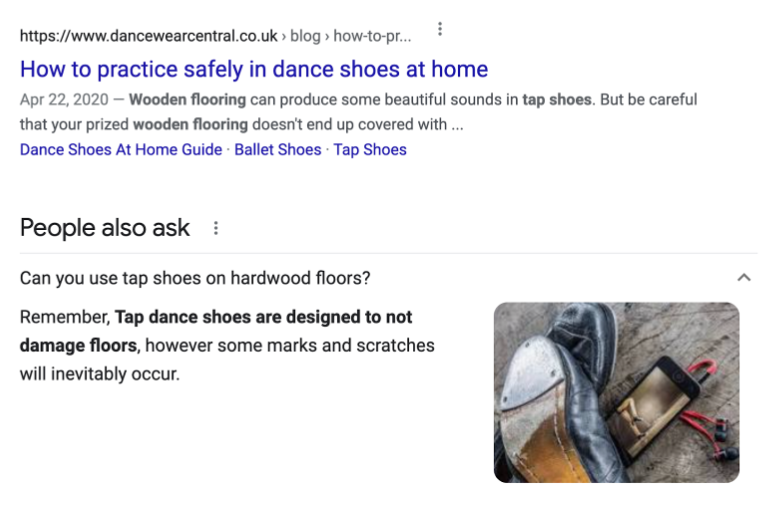
4. Get your NAP identity posted in many places, and boost your SEO and voice search
The more places you have your name, address, and phone number, the better! The first step in giving our online presence the proper NAP due diligence is to claim our business profile on Google. We can verify and update our address and opening hours, add images, and include a short blurb. We want to max out our NAP profiles across all platforms! We can do this by making sure that our listings at business.google.com, bingmapsportal.com, and mapsconnect.apple.com are completely filled out.

5. Optimize your website for responsiveness and speed
Basic housekeeping for your website needs to include page loading time and mobile responsiveness. Here is a great checklist of do’s and don’ts for engineering your pages for best performance. A page that is taking too long to load will make a reader bounce away. There are also analytics to monitor the bounce rate and conversion rate. Mobile performance is ultra-important because most verbal questions are asked via the mobile phone.
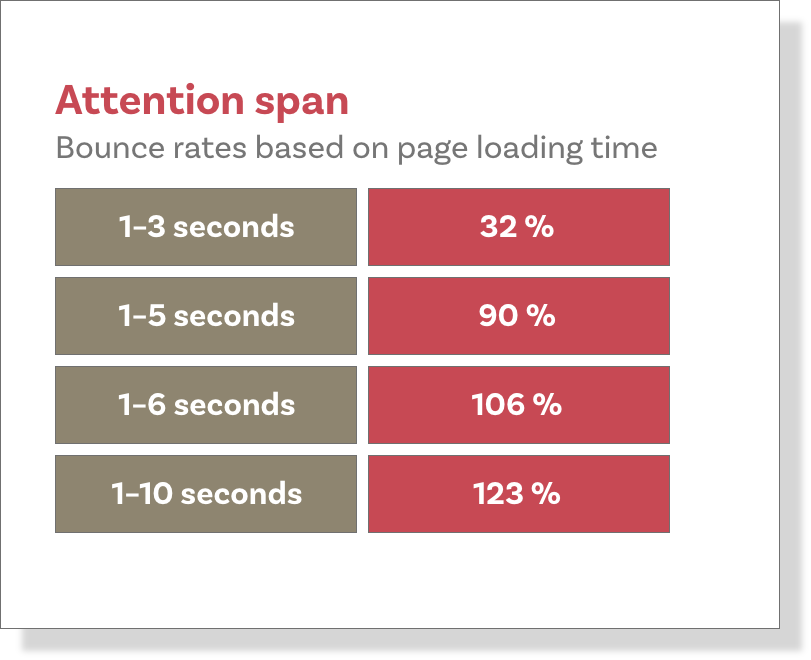
The last word on voice search
In summary, we don’t want to ignore the voice search in our SEO strategy. Integrating these steps will optimize your rankings in voice search, and thereby boost your sales. We will see this trend grow significantly, as it has been already.
Hey Google, send me the business, please.





